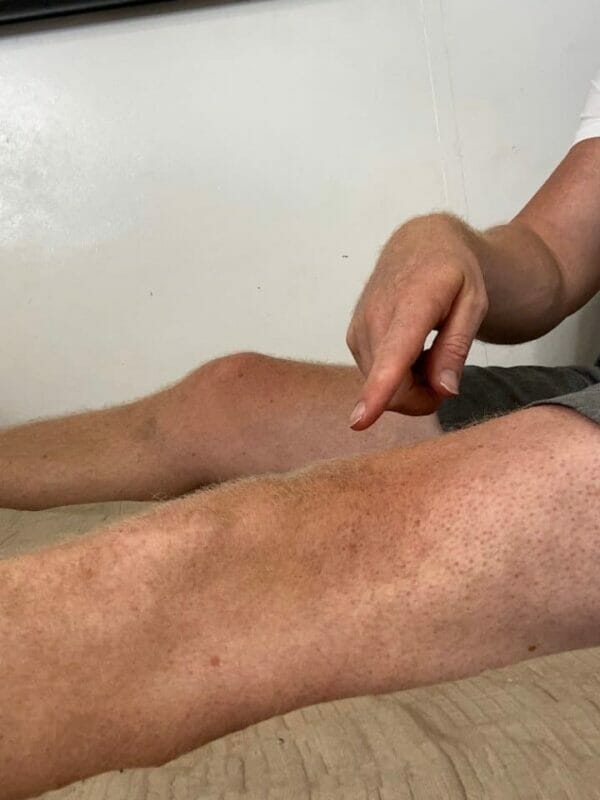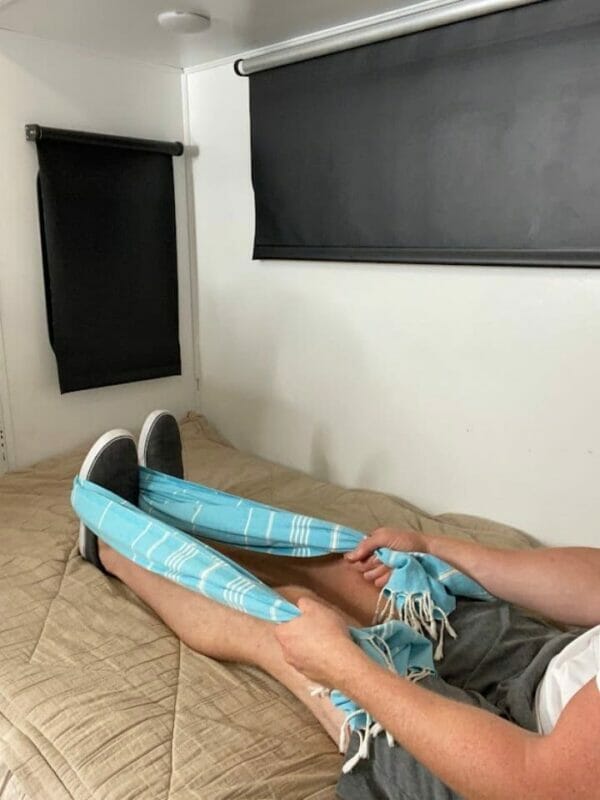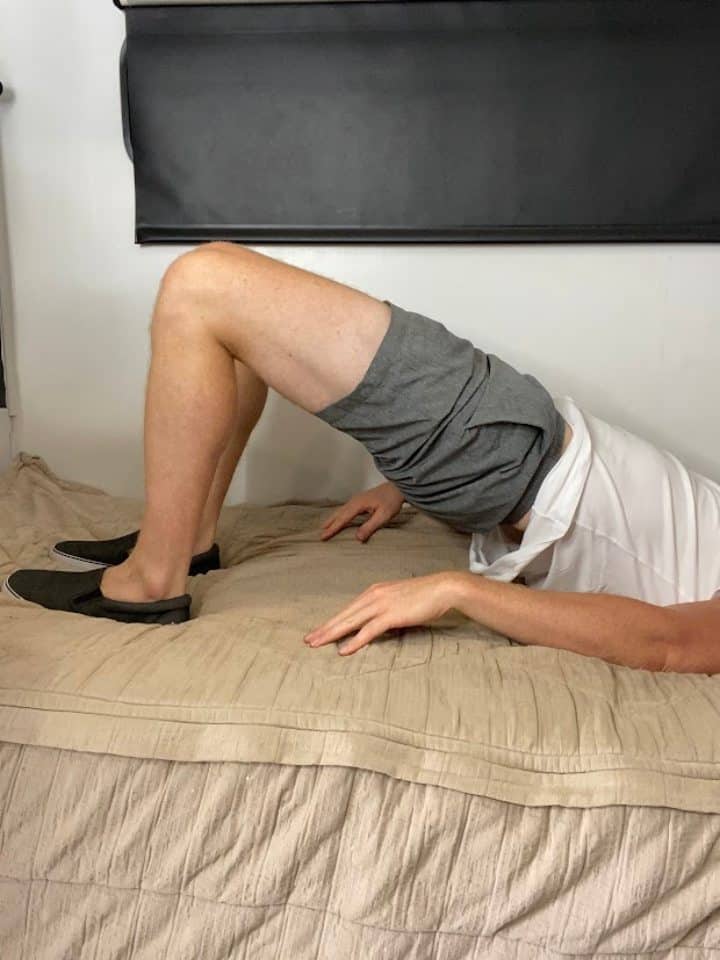Free download: Top 10 Natural & Easy Remedies for Joint Pain from Home. Learn these helpful remedies.
Estimated Reading Time: 12 minutes read

ACL injuries are one of the most common knee injuries that are all too commonly heard about. They’re known for their debilitating effects and long recovery time.
According to the Mayo Clinic, “Around 200,000 people tear their ACL each year.”
If this is the case, then how can an ACL injury be prevented? Is there a way to speed up recovery?
We’ll be taking a look at the basics of ACL injuries, treatment and prevention options available.
Table of Contents
ACL Anatomy and Function

The ACL, or anterior cruciate ligament, is one of four primary ligaments that support the knee. It’s a very important soft tissue in the knee that assists in stabilizing the knee joint.
The anterior cruciate ligament is located in the center of the knee and runs from the femur, or thigh bone, to the tibia, or shin bone.
The anterior cruciate ligament is responsible for controlling anterior tibial translation, or keeping the tibia from moving too far forward, as well as resisting excessive rotational forces.
The other three ligaments that assist in stabilizing the knee joint include the posterior cruciate ligament, medial collateral ligament, and lateral collateral ligament.
An injury to any of these ligaments can create an unstable knee.
ACL Mechanism of Injury
If so many experience an anterior cruciate ligament injury, how do they occur?
Most ACL injuries, particularly ACL tears, commonly occur in the athletic population when playing sports. This is especially true for sports that involve sudden stops, jumping and directional changes such as soccer, football, basketball and hockey.
Almost 75% of ACL injuries are non-contact in nature. Women tend to be more prone for an ACL injury compared to men.
Certain risk factors have been found to try to explain why some may be more susceptible to an ACL tear.
Risk Factors for ACL Injury
Abnormal movement mechanics during the above-mentioned motions can increase risk for anterior cruciate ligament injuries. This is especially true when fatigue is a factor during the activity or sport.
While there are some differing opinions regarding all contributing factors involved in these abnormal movement mechanics, it’s generally thought that most ACL tears can be potentially caused by the following when in motion:
- Poor trunk stability and lateral movement of the torso
- Uneven loading of the limbs
- Uncontrolled alignment of the knee, especially in landing positions: Landing in a valgus position, with the knee almost completely extended and adducted, has been found to create increased stress on the anterior cruciate ligament.
- Muscle imbalances: An unequal balance between the quadriceps and hamstrings are thought to increase risk of ACL tears, with weak hamstrings believed to be a major factor.
How to Know If You Tore Your ACL?

If you tear your ACL, what exactly does it feel like? Will you know right away that you’ve torn it?
The following are the most common signs and symptoms of an anterior cruciate ligament tear:
- Immediate, severe pain in the knee joint
- An audible popping sound or popping sensation in the knee
- Sudden swelling in the knee joint
- Reduced range of motion
- The knee feels unstable
Additional Diagnostic Measures
Your medical doctor or physical therapist will recommend or perform additional special tests to confirm a diagnosis of an ACL tear or rupture.
Imaging, such as an MRI, can be helpful for confirmation of a tear.
Special orthopedic tests also exist to confirm a diagnosis if found to be positive. Some of these tests include the Anterior Drawer test, Lachman test, and Pivot Shift test.
Can You Walk with an ACL Tear?
This is a great question. The answer though really depends on the severity of the injury.
In most cases, you can still walk with a torn ACL. A mild injury, or partial tear, will likely be the easiest type of injury to recover from and initiate walking right away.
You technically can still walk even with a complete tear of the anterior cruciate ligament, depending on the stability of the injured knee.
While walking, you want to absolutely make sure to avoid twisting and rotation. If you play a high impact sport, you’ll have to sit out to avoid further knee damage and get a proper assessment from a sports medicine doctor or orthopedic specialist.
If you’ve sustained a more serious knee injury, such as a complete tear or ruptured ACL with other additional knee injuries, the knee joint may not be stable enough to walk on.
This could occur if other soft tissues are involved in the injury, such as the collateral ligaments, the posterior cruciate ligament, and one or both menisci.
Treatment of ACL Injury
Treatment of ACL tears, again, will depend on the severity of the injury. While some ACL tears are able to be managed conservatively, others require surgical treatments.
Conservative Management of an ACL Tear
An ACL tear that is only a mild injury, such as a partial tear in a non-athlete, may not require any surgical intervention.
You will most likely though be referred to physical therapy to address any deficits you may be experiencing since the initial injury and establish a home program for the best recovery.
Common limitations after an ACL injury will involve swelling, reduced range of motion, and weakness. You may have injured leg difficulty with certain functional tasks, such as bending, squatting, walking, and stairs.
While the type and intensity of your exercise program depends on your individual situation, we’ll take a look at a few basic ACL strengthening exercises that can help after an initial injury.
These are geared to improve range of motion and strength of the leg muscles surrounding the knee, in order to provide better knee stability and support.
Quad Set


- Starting position: Seated with the injured leg stretched in front of you (can be on the floor, couch or bed).
- Squeeze the quadriceps (the muscles on the top of the thigh) and try to press the back of the injured knee down towards the surface.
- Hold for 5 seconds, then relax.
- Repeat 10-15 repetitions for 2-3 sets.
Heel Slides


- Starting position: Sitting or laying down with the injured leg in front of you (can be on the floor, couch or bed).
- Wrap a non-elastic strap around the foot.
- Pull on the strap with the arms to slide the heel towards the bottom while simultaneously bending the knee.
- Hold 5 seconds, then return to your starting position.
- Repeat 10-15 repetitions for 2-3 sets.
Hamstring Curl


While there are a few positions to do a hamstring curl, we’ll focus on one of the most simple positions.
- Starting position: Seated in a chair with a resistance band tied around the ankles (light, medium or heavy resistance). Place the feet flat on the floor and slightly in front of you.
- Slide the injured leg back towards you, bending the knee as far as able.
- Hold 5 seconds, then return to your starting position.
- Repeat 10-15 repetitions for 2-3 sets.
Bridge


- Starting position: Laying on your back with the knees bent and feet flat on the surface (can lay on the floor, couch or bed).
- Lift the hips off the surface as high as able, hold for up to 5 seconds, then return to your starting position.
- Repeat 10-15 repetitions for 2-3 sets.
Mini Squat


- Starting position: Standing in front of a sturdy surface, such as your countertop, with the feet about hip width apart.
- Slowly sit the hips back towards the heels, while bending the knees to about a 45 degree angle. Your torso should slightly incline forward to counterbalance the weight moving towards the heels.
- Hold up to 5 seconds, then return to your starting position.
- Repeat 10-15 repetitions for 2-3 sets.
Straight Leg Raise


- Starting position: Laying flat on your back with the injured leg straight in front of you and the healthy knee bent with the foot flat on the surface (can lay on the floor, couch or bed).
- Squeeze the quadriceps, just like in the quad set.
- Hold this squeeze, keeping the knee straight, and lift the entire injured leg in one motion off the surface. Lift the leg until the thighs are at an equal height with each other.
- Lower and return to your starting position.
- Repeat 10-15 repetitions for 2-3 sets.
Single Leg Balance


Balancing on the injured leg is a great challenge for stability and strength.
- Starting position: Standing in front of a sturdy surface, such as your countertop.
- Shift all of your weight onto the injured leg (avoid locking into the knee joint), picking the opposite foot up off the floor.
- Practice balancing for 30 seconds (can use the counter for balance assist as needed).
- Return to your starting position to take a break.
- Repeat 1-2 more times.
While many may be able to recovery from their ACL partial tear without surgery, there are potential risks to consider. Potential long-term effects of an ACL tear without surgical correction may include the following:
- Not able to return to previous sport or recreational activity
- Knee instability
- Additional knee injuries
Rehabbing a torn ACL without surgery can take anywhere from a few weeks to a few months, depending on the severity of the tear and your functional limitations.
Surgery for an ACL Tear
A more serious injury, such as a complete ACL tear or rupture, may require orthopedic surgery to restore knee function. For those who play sports, this unfortunately can be the type of injury and surgery to put you on the sidelines for an entire season.
The standard surgical options include an ACL repair versus ACL reconstruction.
ACL Repair
An ACL repair is considered less intensive than reconstruction, but reconstructions can be more common.
There has been more investigation into the benefits of performing a repair on a proximal ACL tear. Pros of the repair advocate that it’s a less invasive procedure, less trauma to surrounding soft tissues, sooner overall recovery, and less complicating factors.
ACL Reconstruction
Anterior cruciate ligament reconstruction typically involves use of a graft to replace the injured anterior cruciate ligament.
A graft may be an autograft or an allograft. An autograft is a soft tissue graft from your own body, whereas an allograft comes from a cadaver.
The most common anterior cruciate ligament autografts come from the patellar or hamstring tendons, but can also come from other nearby soft tissues.
Which graft is used during anterior cruciate ligament reconstruction will ultimately be decided by your surgeon. This choice is usually based on factors, such as your age, medical history and activity level and type.
Surgical Recovery
The full timeline for recovery after surgery can be anywhere from 6-9 months, although some may take a full year to return to normal functioning and sporting or recreational activities.
You’ll typically use some type of assistive device, such as crutches or a walker, with a leg brace immediately after surgery. Physical therapy should begin right away and will typically follow a post-operative rehab protocol to properly progress the leg after surgery.
The initial phase of rehab will be focused on regaining normal range of motion, pain management, swelling, and leg strength. As time goes on, you will eventually be able to resume higher level activities, such as running and return to sports.
Pain management is very important throughout recovery, and will likely include lots of icing, pain medications, and nonsteroidal anti inflammatory drugs. If you don’t feel like you’re pain is being managed properly, it’s important to discuss this with your surgeon and physical therapist.
ACL Injury Prevention

After learning how to treat and manage an ACL injury once it has already happened, a very important concept would be how to prevent an ACL tear in the first place.
Make sure to have a well-rounded strengthening routine in place. This should include full leg and core strengthening to assist in keeping the knee stable, especially during dynamic, multi-plane movements.
If you participate in a sport that requires jumping or sudden changes in direction, make sure to include exercises and agility drills to practice these tasks with the correct body mechanics.
Always make sure to incorporate a good warm-up prior to an activity or game. A proper active warm-up is always one of the best ways to reduce any type of injury, including an ACL injury.
With all of the above measures in place, you’ll not only notice an improvement in your day-to-day mobility and skill set, but will help to drastically reduce your risk of an anterior cruciate ligament injury.
FAQ:
Should I wear a knee brace if I’ve torn my ACL?
A knee brace can be helpful when you’re initially rehabbing a non-surgical ACL injury.
As you progress throughout physical therapy though, you’ll want to wean off the brace to encourage your own soft tissues and joint to support themselves without outside help.
Who should I see about an ACL injury?
An orthopedic surgeon is the best specialist to see after an initial injury. They will be able to tell if you’ll need surgery and will make a referral to a physical therapist to help in your recovery.
Will I be able to do everything I used to do after ACL surgery?
Most are able to return to their prior level of functioning after ACL surgery if they actively participate and comply with their rehab program.
While the severity of the injury and timeline in which it’s addressed are all factors to consider, most are eventually able to make a full recovery.













